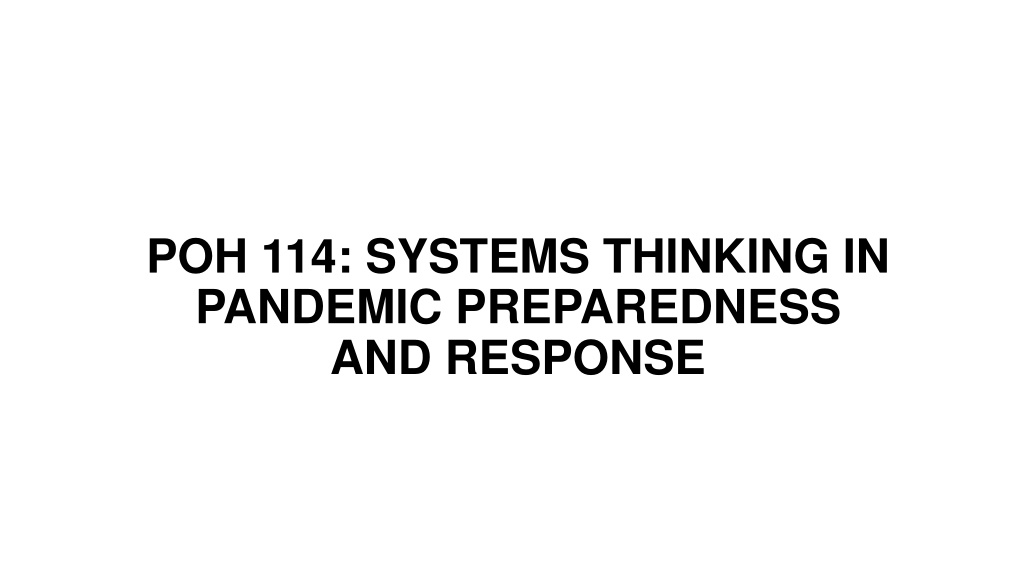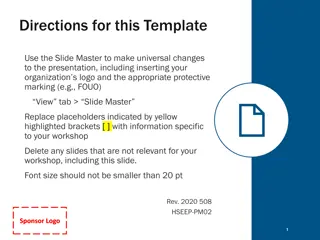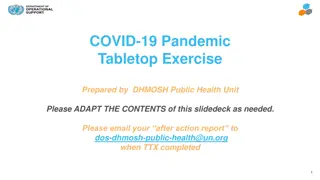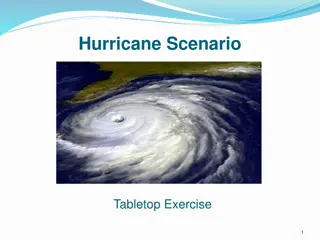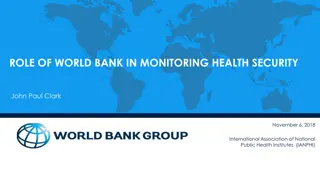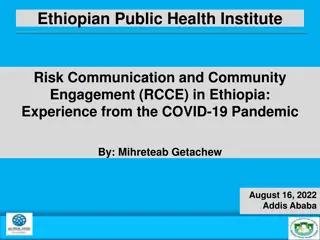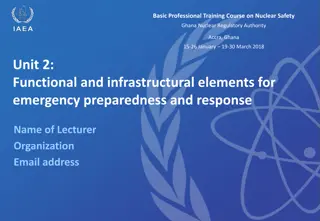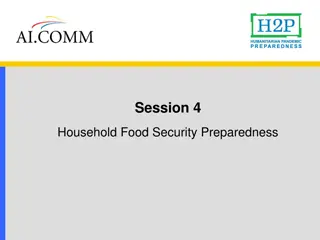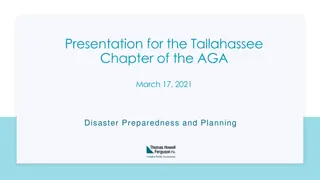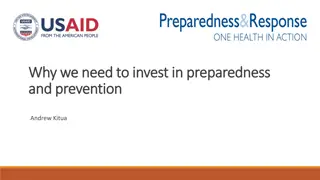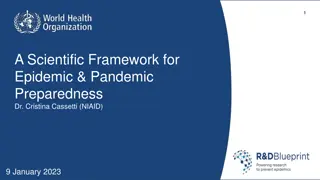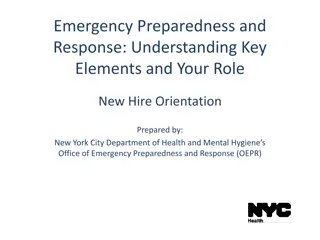Systems Thinking in Pandemic Preparedness and Response
This topic focuses on the application of systems thinking in pandemic preparedness and response. It explores the inter-relationships among system elements to influence outcomes in complex, unpredictable environments. Learners will develop competencies in understanding complex problems, creating solutions using system thinking maps, and improving multi-sectoral cooperation in health systems.
- Systems Thinking
- Pandemic Preparedness
- One Health Interventions
- Complex Problems
- Interdisciplinary Collaboration
Download Presentation

Please find below an Image/Link to download the presentation.
The content on the website is provided AS IS for your information and personal use only. It may not be sold, licensed, or shared on other websites without obtaining consent from the author. Download presentation by click this link. If you encounter any issues during the download, it is possible that the publisher has removed the file from their server.
E N D
Presentation Transcript
POH 114: SYSTEMS THINKING IN PANDEMIC PREPAREDNESS AND RESPONSE
Purpose This topic seeks to facilitate learning of the inter-relationships among system elements, and the interactions of systems in complex, unpredictable environments to influence outcomes in pandemics and emergencies.
Objectives This topic enables learning about: Systems thinking, core concepts of its theories and characteristics, and their application in One Health interventions. Systems thinking skills and tools in mapping One Health problems and create solutions to problems with practical strategies useful for field investigations. One Health systems thinking skills to improve inter-professional, inter- discipline and cross-sectoral collaboration on key disease surveillance and outbreaks. Systems thinking skills to improve multi-sectoral cooperation among national, regional and international government health officials along with multilateral health agencies in One Health interventions.
Expected Learning Outcomes At the end of this course the learner should be able to: Define systems thinking, the core concepts of its theories and characteristics, and their interventions. Apply systems thinking tools for mapping One Health problems and create solutions to problems with practical strategies useful for field investigations. Demonstrate One Health systems thinking to improve national, regional and international, inter-professional, inter-disciplinary and cross-sectoral collaboration on key disease surveillance and outbreaks application in One Health
Competencies Competency 1 Understand and describe the elements of complex problems and systems thinking Competency 2 Create and use systems thinking maps to deepen understanding of OH problems Competency 3 Develop solutions to OH wicked problems using systems thinking.
SystemsThinkingforHealthSystems Foundations 5 2000 2007 2008 2012 2017 2009
Analytical Thinking Understand what the various parts do Take it apart Assemble the understanding of the parts into an understanding of the whole
What is a System ? System elements System elements that work together or interact System elements that work together to fulfill a purpose
Health Systems WHO s Original HealthSystemsFrameworkby2008 7 How Health Systems work. Inputsand Processes Outputs Outcomes Impact Improved: survival nutrition equity Governance Financing Effective Coverage Responsiveness Service delivery Human resources Medicines Reduced: morbidity impoverishment Information But is this simple linear logic the way things really work? Modified from: WHOEverybody s business, 2008 & Health Metrics Network Framework
Systems Thinking 1. What is this a part of ? 2. What is the behavior of the whole ? 3. Disaggregate the understanding of the whole by identifying the role of the thing you are trying to explain = Why things work the way they do.
11 SystemsThinking Systems thinking gives deeper insights into: 1. How a system works, 2. Why it has problems, 3. How it can be improved Graphic adapted from AhnA.C. et al. PLoS Med 3:956-960 (2006).
12 SystemsThinking Systems thinking involves shifting attention parts whole, from the to the from objects to relationships, from structures to processes, from hierarchies to networks, from rational to intuitive, from analysis to synthesis, from linear to non-linear thinking. Adapted from Fritjof Capra
Some System Characteristics Most Systems, including health systems, are: Self-organizing Constantly changing Tightly linked Governed by feedback Non-linear History dependent Counter-intuitive Resistant to change Compiled and adapted from Sterman,2006 and Meadows et al, 1982 (32;42)
Connections and Consequences of Systems Thinking The following are important to understand Systems thinking. 1. Understand the context of the system 2. Find connections between the parts, actors and processes of the system 3. Anticipate rather than react to the downstream consequences of changes in the system.
Skills in Systems Thinking Traditional approach 1. Static thinking (Focusing on particular events) 2. Systems -as- effect thinking (Viewing behavior generated by a system as driven by external forces) 3. Tree by Tree Thinking (Believing that really knowing something means focusing on the details) 4. Factors thinking (Listing factors that influence or correlate with some result) 5. Straight-line thinking (Viewing causality as running in one direction ignoring the interdependence and interaction between and among the causes) Systems thinking approach 1. Dynamic thinking (Framing a problem in terms of a pattern of behavior over time) 2. Systems -as-cause thinking (Placing responsibility for a behavior on internal actors who manage the policies and plumbing of the systems) 3. Forest thinking (Believing that to know something requires understanding the context of relationships 4. Operational thinking (Concentrating on causality and understanding how behavior is generated) 5. Loop thinking (Viewing causality as an on-going process, not a one-time event, with effect feeding back to influence the causes and the causes affecting each other). Modified from Richmond, 2000(28)
13 Small changes can produce big results ! Tipping points but points of highest leverage are least obvious There are no rules for finding tipping points, but there are ways of thinking that make it more likely. Learning to look system-wide underlying processes, contexts rather than "events" is a starting point... and see and approaches
14 Tipping Points Leverage points when intervening in a system (in decreasing order of effectiveness) 1. The mind-set or paradigm out of which the system its goals, power structure, rules, culture arises. 2. Goals of the system Governance 3. Distribution of power over the rules of the system 4. Rules of the system (incentives, constraints) 5. Information flows 6. Material flows 7. Driving positive feedback loops. We tend to work mainly at these levels 8. Regulating negative feedback loops 9. Constants, parameters, numbers, subsidies Modified from Donella Meadows
Systems Thinking in One Health OH Challenge
Systems Thinking Who has the disease Who is impacted by the disease? Who are the responders? Who are other stakeholders? OH Who Challenge
Systems Thinking Who has the disease Who is impacted by the disease? Who are the responders? Who are other stakeholders? Who OH Challenge Where was the first case? Where has it spread? Where
Systems Thinking Who has the disease Who is impacted by the disease? Who are the responders? Who are other stakeholders? Who OH Challenge Where was the first case? Where has it spread? When was the first case? How quickly is it spreading? When Where
Systems Thinking Who has the disease Who is impacted by the disease? Who are the responders? Who are other stakeholders? Who How is the disease transmitted? How serious is it? How can it be managed or controlled? Where was the first case? Where has it spread? OH How Where Challenge When When was the first case? How quickly is it spreading?
Systems Thinking Who has the disease Who is impacted by the disease? Who are the responders? Who are other stakeholders? Who What are the implications for human health? Animal health? Ecological health? Where was the first case? Where has it spread? What Where OH Challenge When was the first case? How quickly is it spreading? How is the disease transmitted? How serious is it? How can it be managed or controlled? How When
Systems Thinking Who has the disease Who is impacted by the disease? Who are the responders? Who are other stakeholders? Who Why did the outbreak occur? Why Where Where was the first case? Where has it spread? OH Challenge When was the first case? How quickly is it spreading? What are the implications for human health? Animal health? Ecological health? What When How is the disease transmitted? How serious is it? How can it be managed or controlled? How
Constructing System Maps Introduction Baseline maps (before interventions) Map out interventions Map after intervention (conclusion)
Format of a Systems Diagram The following are the main steps in drawing system map: 1. Identify the main issue on which to draw a system of interest 2. Draw the main boundary around the system of interest, thereby specifying what falls within the system itself and what is in the environment 3. Identify each sub-system and draw a blob around it to establish its boundary. 4. Name the following;- a) the system (title of the main system of interest) b) components of subsystems c) elements in the environment
Systems Thinking What is a wicked Problem Finding Solutions to One Health Wicked Problems through Systems Thinking
Wicked Problems. There is no right way to approach a wicked problem They are complex They require multiple kinds of thinking. They need multiple perspectives. That is why One Health brings together a multi- disciplinary team to tackle some of the most complex health problems.
24 SystemsThinkingToolsforHealthSystemsResearch Tools for describing and analysing situations To visualize emergent behaviour and explore non-linear interrelationships Causal Loop Diagrams To explore consequences of non-linear relationships and modelling and testing solutions in whole systems Systems Dynamics modeling To identify and map the stakeholders, the relations among stakeholders, and the structure of their network/systems Social Network Analysis To plan, monitor and evaluate how complex interventions contribute to outcomes Outcome Mapping To understand processes and how information flows in complex multi-stakeholder settings Process Mapping
25 SystemsThinkingToolsforHealthSystemsResearch Tools for changing and managing situations For understanding processes and how interventions might integrate and work in the system Process mapping & modeling For framing research methodological design in relation to the system boundaries Boundary critique Approach for stakeholder and researcher participatory reflection on the problem Soft systems methodologies Sense making framework to distinguish simple, complicated, complex and chaotic situations and guide to managing risk Complexity Analysis (Cynefin) Asuite of tools for understanding self-organizing behaviour of actors in the system Human systems dynamics For simulating and reflecting on alternative solutions in strategic planning Scenario technique
Application of Systems Thinking Tools and Approaches 2 For presentation in this symposium
References Chepsaa https://www.hpsa-africa.org/ LSHTM https://www.lshtm.ac.uk/ Bradley DT, Mansouri MA, Kee F, Garcia LMT. A systems approach to preventing and responding to COVID-19. Clinical Medicine. 2020:100325. doi: 10.1016/j.eclinm.2020.100325 (https://www.ncbi.nlm.nih.gov/pmc/articles/PMC7118639/). Brown G, Reeders D., Cogle A., Madden A., Kim J, O Donnell D. A Systems thinking approach to understanding and demonstrating the role of Peer-Led programs and leadership in the response to HIV and Hepatitis C: Findings from the W3 Project. Front Public Health. 2018; 6:231. Doi: 10.3389/fpubh.2018.00231 (https://www.ncbi.nlm.nih.gov/pmc/articles/PMC6127267/pdf/fpubh-06- 00231.pdf). Chakraborty I, Maity P. COVID-19 outbreak: migration, effects on society, global environment and prevention. Sci Total Environ. 2020 Apr 22 ;728 :138882. doi: 10.1016/j.scitotenv.2020. (https://www.ncbi.nlm.nih.gov/pmc/articles/PMC7175860/pdf/main.pdf).National Incident Management System (NIMS). IS 800: http://www.training.fema.gov?EMIWeb/IS/is800.asp
Review of The Pandemic Preparedness with One Health approach (PPOH) short course is by the East African Community (EAC) Secretariat in cooperation with universities of the six EAC Partner States. It is facilitated by the German Government and implemented by the Deutsche Gesellschaft f r Internationale Zusammenarbeit GIZ GmbH through the Global Programme Pandemic Prevention and Response, One Health (GP PPOH)
